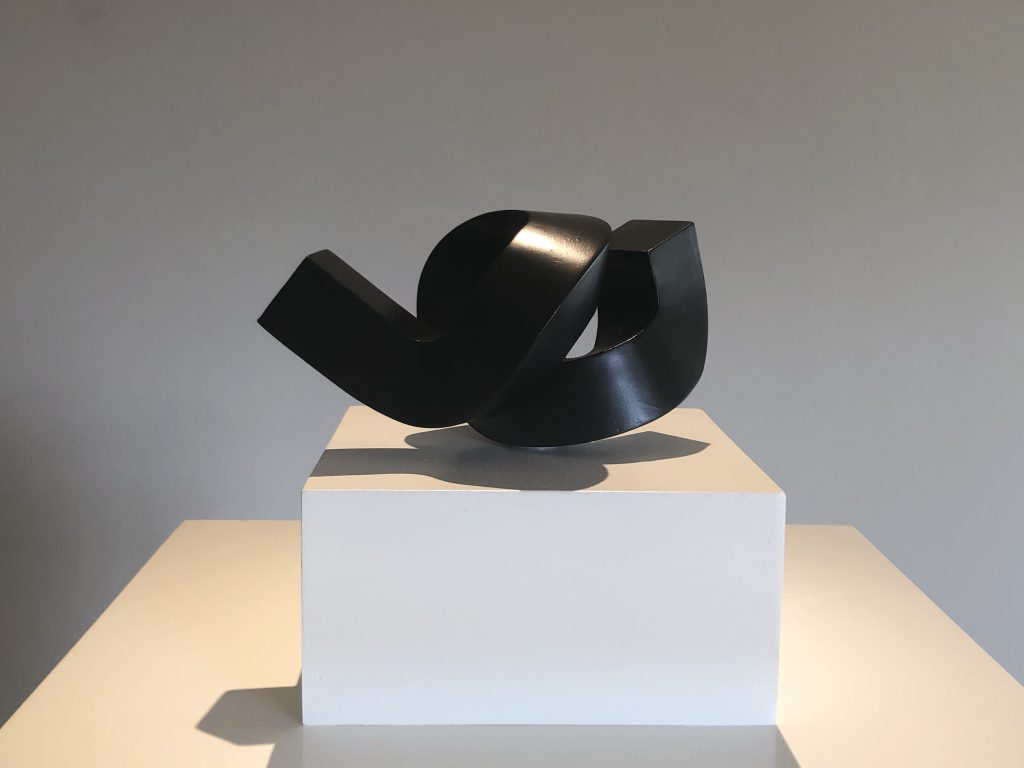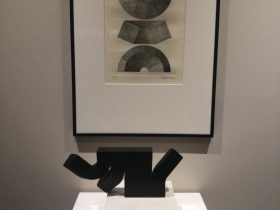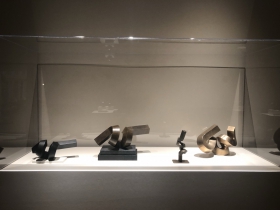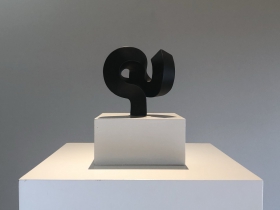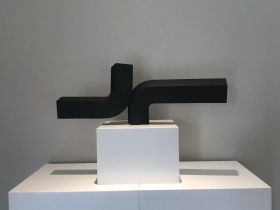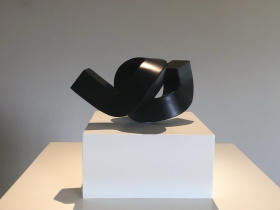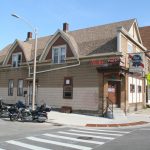Here Comes Clement Meadmore
Lynden Sculpture Garden’s indoor show offers models of his large, playfully precise sculptures.
The Lynden Sculpture Garden’s latest exhibition, Clement Meadmore: The Models (on display through March 31), features eight models of renowned Australian-born sculptor Clement Meadmore (1929-2005), which were (and continue to be) used to create large-scale works of public art around the globe.
Meadmore originally studied aeronautical engineering and after graduating from the Royal Melbourne Institute of Technology, he began designing furniture and soon gravitated to art, creating his first sculpture of welded steel in 1953. By the 1960s he had settled in New York City and later became a U.S. citizen. There are elements of both modernism and minimalism in his work, which has won global acclaim.
Meadmore’s large outdoor sculptures, Upstart (1967) and Double Up (1970), (which resemble a pair of index fingers and thumbs pointing upwards) are a part of the Lyndon’s permanent collection.
“Clement Meadmore: The Models continues our exploration of the work and creative processes of artists in our collection, many of whom were also making smaller sculpture, furniture, or works on paper,” writes Lynden executive director Polly Morris.
Meadmore’s background in aeronautical engineering and furniture design are reflected in his passion for precision, form and symmetry. A framed picture of one of his etchings on paper (22 x15 inches), half-circle shapes with cross-hatching and other shading techniques, hangs on the wall in the front foyer of the gallery.
Reminiscent of a protractor, this etching illustrates Meadmore’s fascination with shapes and their spatial relationships.
During my recent visit to Lynden, Morris noted that the artist’s sculptures are “fiercely geometrical.”
“He is very interested in balance and motion,” she added.
However, the artist’s works are abstract and anything but rigid. When viewed from different angles, Meadmore’s models, with their many unexpected curves, appear multi-dimensional, taking on new shapes.
The sculptor worked primarily with Cor-TEN steel. Meadmore reportedly chose this medium for the way it develops a rust-colored finish, which reminded him of abandoned industrial structures.
Many of his models, including Wall for Bojangles (5 ½ x 14 x 6 inches) Delaunay’s Dilemma (7 x 8 x5 inches) and Swash (4 ½ x 9 ½ x 6 inches), are made out of a black polymer resin, giving them an elegant, sleek appearance.
Four sculptures are enclosed in a vitrine. Several are made out of bronze; Here Comes Charlie, for example, appears to be highly polished, almost gleaming. Hobnob, 1992 (6 x 16 x 8 inches), has more of the typical dull bronze sheen.
The gallery’s overhead lighting produces a dramatic shadowing effect on some of Meadmore’s works, which at first glance appears to be part of the sculpture.
Meadmore was an ambitious artist, designing works of all scales, from palm-sized to life-sized to large-scale. Many of his public art sculptures span over 25 feet. Meadmore even planned to design a 600-foot sculpture (which never materialized).
His bronze model Uprising (9 x 4 x 4 inches), which spirals skyward, could reflect the artist’s ability to “think big.” Several of his works contain the words “up” or “out” in the title—Upstart, Double Up, Outspread, Uprising. Meadmore’s works share a common theme of optimism and forward thinking.
Morris said Meadmore’s smaller sculptures are widely sought after among private art collectors.
His contribution to public art continues to be significant. According to Meadmore’s website, “his sculptures deny their physical reality, suggesting weightlessness. Because of this extroverted and animated character, his public commissions provide oases of humanity in the urban environment.”
“Clement Meadmore: The Models” Gallery
“Clement Meadmore: The Models,” through March 31 at the Lynden Sculpture Garden, 2145 W. Brown Deer Rd.
If you think stories like this are important, become a member of Urban Milwaukee and help support real independent journalism. Plus you get some cool added benefits, all detailed here.
Art
-
Winning Artists Works on Display
 May 30th, 2024 by Annie Raab
May 30th, 2024 by Annie Raab
-
5 Huge Rainbow Arcs Coming To Downtown
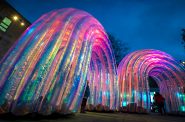 Apr 29th, 2024 by Jeramey Jannene
Apr 29th, 2024 by Jeramey Jannene
-
Exhibit Tells Story of Vietnam War Resistors in the Military
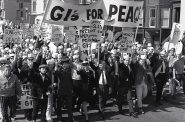 Mar 29th, 2024 by Bill Christofferson
Mar 29th, 2024 by Bill Christofferson



